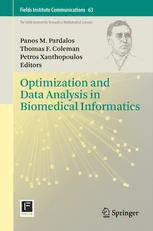Table Of ContentFields Institute Communications
VOLUME 63
The Fields Institute for Research in Mathematical Sciences
FieldsInstituteEditorialBoard:
CarlR.Riehm,ManagingEditor
EdwardBierstone,DirectoroftheInstitute
MatheusGrasselli,DeputyDirectoroftheInstitute
JamesG.Arthur,UniversityofToronto
KennethR.Davidson,UniversityofWaterloo
LisaJeffrey,UniversityofToronto
BarbaraLeeKeyfitz,OhioStateUniversity
ThomasS.Salisbury,YorkUniversity
NorikoYui,Queen’sUniversity
TheFieldsInstituteisacentreforresearchinthemathematicalsciences,locatedin
Toronto,Canada.TheInstitutesmissionistoadvanceglobalmathematicalactivity
intheareasofresearch,educationandinnovation.TheFieldsInstituteissupported
bytheOntarioMinistryofTraining,CollegesandUniversities,theNaturalSciences
and Engineering Research Council of Canada, and seven Principal Sponsoring
Universities in Ontario (Carleton, McMaster, Ottawa, Toronto, Waterloo, Western
andYork),aswellasbyagrowinglistofAffiliateUniversitiesinCanada,theU.S.
andEurope,andseveralcommercialandindustrialpartners.
Forfurthervolumes:
http://www.springer.com/series/10503
Panos M. Pardalos • Thomas F. Coleman
Petros Xanthopoulos
Editors
Optimization and Data
Analysis in Biomedical
Informatics
123
TheFieldsInstituteforResearch
intheMathematicalSciences
Editors
PanosM.Pardalos ThomasF.Coleman
CenterforAppliedOptimization DepartmentofMathematics
DepartmentofIndustrialand UniversityofWaterloo
SystemsEngineering Waterloo,ON,Canada
UniversityofFlorida
Gainesville,FL,USA
and
PetrosXanthopoulos
LaboratoryofAlgorithmsandTechnologies DepartmentofIndustrialEngineering
forNetworksAnalysis(LATNA) andManagementSystems
NationalResearchUniversity UniversityofCentralFlorida
HigherSchoolofEconomics Orlando,FL,USA
Moscow,Russia
ISSN1069-5265 ISSN2194-1564(electronic)
ISBN978-1-4614-4132-8 ISBN978-1-4614-4133-5(eBook)
DOI10.1007/978-1-4614-4133-5
SpringerNewYorkHeidelbergDordrechtLondon
LibraryofCongressControlNumber:2012939726
©SpringerScience+BusinessMediaNewYork2012
Thisworkissubjecttocopyright.AllrightsarereservedbythePublisher,whetherthewholeorpartof
thematerialisconcerned,specificallytherightsoftranslation,reprinting,reuseofillustrations,recitation,
broadcasting,reproductiononmicrofilmsorinanyotherphysicalway,andtransmissionorinformation
storageandretrieval,electronicadaptation,computersoftware,orbysimilarordissimilarmethodology
nowknownorhereafterdeveloped.Exemptedfromthislegalreservationarebriefexcerptsinconnection
with reviews or scholarly analysis or material supplied specifically for the purpose of being entered
and executed on a computer system, for exclusive use by the purchaser of the work. Duplication of
this publication or parts thereof is permitted only under the provisions of the Copyright Law of the
Publisher’slocation,initscurrentversion,andpermissionforusemustalwaysbeobtainedfromSpringer.
PermissionsforusemaybeobtainedthroughRightsLinkattheCopyrightClearanceCenter.Violations
areliabletoprosecutionundertherespectiveCopyrightLaw.
Theuseofgeneraldescriptivenames,registerednames,trademarks,servicemarks,etc.inthispublication
doesnotimply,evenintheabsenceofaspecificstatement,thatsuchnamesareexemptfromtherelevant
protectivelawsandregulationsandthereforefreeforgeneraluse.
While the advice and information in this book are believed to be true and accurate at the date of
publication,neithertheauthorsnortheeditorsnorthepublishercanacceptanylegalresponsibilityfor
anyerrorsoromissionsthatmaybemade.Thepublishermakesnowarranty,expressorimplied,with
respecttothematerialcontainedherein.
Printedonacid-freepaper
SpringerispartofSpringerScience+BusinessMedia(www.springer.com)
Preface
As science and society as a whole become more and more information intensive,
there is an urgentneedto develop,create,and applynew algorithmsandmethods
to model, manage, and interpret this information. This is nowhere more evident
than in biomedicine, where clinicians and scientists are routinely faced with
conflicting (sometimes contradictory) sources of knowledge, in addition to the
overwhelming and ever increasing stream of data. Bioinformatics and the -omics
(genomics,proteomics,etc.)heraldtheadventofaneweraandanewparadigmfor
scientificand,inparticular,biomedicalresearch.Togetherwiththetoolsdeveloped
inoptimizationtheoryandthemathematicalsciences,weareatacrossroads,where
amorefundamentalunderstandingofbiologicalprocessesiswithinourgrasp.This
understanding will certainly pave the way for a more systematic attack on the
mechanicsof diseases, as opposed to a naive treatmentof their symptoms(which
hasbeenthehallmarkofclassicalmedicine).Itseemsclearthatthereisanurgent
need in biomedicine for new methods that will make sense out of clinical and
experimentaldata thatcan be used to learnand generaterationalhypothesesfrom
thedataandhencetoadvancetheunderlyingdisciplines.
In this volume we cover some of the topics that are related to this emerging
and rapidly growing field. In June 11–12, 2010, we organizeda Workshop on
Optimization and Data Analysis in Biomedical Informaticsat the Fields Institute.
Followingthiseventwegatheredinvitedcontributionsbasedonthetalkspresented
at the workshop and additional invited chapters from world leading experts. We
asked the authors to share their expertise in the form of state-of-the-art research
andreviewchapters.Ourgoalwastobringtogetherresearchersfromdifferentareas
andemphasizethevalueofmathematicalmethodsintheareasofclinicalsciences.
This volume is targeted to applied mathematicians, computer scientists, industrial
engineers, and clinical scientists who are interested in exploring emerging and
fascinatinginterdisciplinarytopicsofresearch.Wehopethatthisbookwillstimulate
and enhance fruitful collaborations between scientists from different disciplines.
TheeditorswouldliketoacknowledgetheFieldsInstitutefortheirfinancialsupport
v
vi Preface
and hospitality. In addition, we would like to thank all the authors of the invited
chapters as well as Mrs. Debbie Iscoe for her valuable help during the editing of
thisvolume.
Gainesville,FL PanosM.Pardalos
Waterloo,ON ThomasF.Coleman
Orlando,FL PetrosXanthopoulos
Contents
NovelBiclusteringMethodsforRe-orderingDataMatrices................ 1
PeterA.DiMaggioJr., AshwinSubramani,andChristodoulos
A.Floudas
ClusteringTimeSeriesDatawithDistanceMatrices........................ 41
OnurS¸erefandW.ArtChaovalitwongse
MathematicalModelsofSupervisedLearningandApplication
toMedicalDiagnosis............................................................. 67
RobertaDeAsmundisandMarioRosarioGuarracino
Predictive Model for Early Detectionof Mild Cognitive
ImpairmentandAlzheimer’sDisease.......................................... 83
EvaK.Lee,Tsung-LinWu,FeliciaGoldstein,andAllanLevey
StrategiesforBiasReductioninEstimationofMarginalMeans
withDataMissingatRandom.................................................. 99
BaojiangChenandRichardJ.Cook
Cardiovascular Informatics: A Perspective on Promises
andChallengesofIVUSDataAnalysis........................................ 117
IoannisA.KakadiarisandE.GerardoMendizabalRuiz
An Introductionto the Analysis of FunctionalMagnetic
ResonanceImagingData........................................................ 131
Gianluca Gazzola, Chun-An Chou, Myong K. Jeong,
andW.ArtChaovalitwongse
SensoryNeuroprostheses:FromSignalProcessingandCoding
toNeuralPlasticityintheCentralNervousSystem.......................... 153
FivosPanetsos,AbelSanchez-Jimenez,andCeliaHerrera-Rincon
vii
viii Contents
EEGBasedBiomarkerIdentificationUsingGraph-Theoretic
Concepts:CaseStudyinAlcoholism........................................... 171
VangelisSakkalisandKonstantinosMarias
MaximalConnectivityandConstraintsintheHumanBrain............... 191
RomanV.Belavkin
Novel Biclustering Methods for Re-ordering
Data Matrices
PeterA.DiMaggioJr.,AshwinSubramani,andChristodoulosA.Floudas
Abstract Clusteringoflarge-scaledatasetsisanimportanttechniquethatisused
for analysis in a variety of fields. However,a number of these methods are based
on heuristics for the identification of the best arrangement of data points. In this
chapter, we present rigorous clustering methods based on the iterative optimal
re-ordering of data matrices. Distinct Mixed-integer linear programming (MILP)
modelshavebeenimplementedtocarryoutclusteringofdensedatamatrices(such
as gene expression data) and sparse data matrices (such as drug discovery and
toxicology).Wepresentthecapabilityoftheoptimalre-orderingmethodsonawide
arrayofdatasetsfromsystemsbiology,moleculardiscoveryandtoxicology.
Mathematics Subject Classification (2010): Primary 54C40, 14E20, Secondary
46E25,20C20
Theproblemofdataclusteringisprevalentacrossanumberofdisciplinessuchas
image processing [39], pattern recognition [3], microarraygene expression [27],
informationretrieval [68] andproteinstructureprediction [60,74,86].In general,
theaimofanyclusteringapproachistoidentify“similar”elementsinthedataset,
andtoorganizeitsothatelementswithsimilarattributesarebroughttogether.
The mostcommonapproachesto clusteringcanbe categorizedas hierarchical
[27]orpartitioning [35]clusteringalgorithms.Althoughalgorithmstoidentifythe
optimalsolutionstothesecategoriesofproblemsdoexist[8,71,72],mostalgorithms
P.A.DiMaggioJr.
DepartmentofMolecularBiology,PrincetonUniversity,Princeton,NJ08540,USA
e-mail:[email protected]
A.Subramani•C.A.Floudas((cid:2))
DepartmentofChemicalandBiologicalEngineering,Princeton
University,Princeton,NJ08540,USA
e-mail:[email protected];fl[email protected]
P.M.Pardalosetal.(eds.),OptimizationandDataAnalysisinBiomedicalInformatics, 1
FieldsInstituteCommunications63,DOI10.1007/978-1-4614-4133-5 1,
©SpringerScience+BusinessMediaNewYork2012
2 P.A.DiMaggioJr.etal.
endupwithsuboptimalsolutionsbecauseoftheuseofheuristicsearchtechniques
andtheidentificationoflocalsolutions.Whileanumberofapproacheslikemodel-
basedclustering [26,84],neuralnetworks [40],simulatedannealing [44],genetic
algorithms [9,66], decomposition-based clustering [76–78], information-based
clustering [73]anddataclassification [14,63]havebeenproposedinliterature,the
fieldof rearrangementclusteringhasrecentlyemergedasa veryusefulalternative
methodforminimizingthesumofpairwisedistancesbetweenrowsandcolumnsto
reachthe optimalsolution.Ithasbeenshownthatthisproblemcan beformulated
as an instance of the traveling salesman problem (TSP), which can be solved to
optimality [53,54].
Abiclusterisdefinedasasubmatrixoftheoriginalmatrix,whichspansasubset
ofrowsandcolumns.Thisway,commonelementscouldbesharedamonganumber
ofbiclusters.ThisproblemhasbeenclassifiedasanNP-hardproblem [16].Anex-
ampleoftheapplicationofbiclusteringmethodsisthestudyofdownstreameffects
ofglobalchangesinregulatedgeneexpression,asmeasuredbyDNAmicroarrays.
The aforementioned clustering techniques would fail to uncover genes which are
involved in more than one biological process or which are co-expressed under
limited conditions [82].This isbecause in anattemptto generatebiclusters,most
algorithmseithersimplifytheproblemrepresentationoremployheuristicmethods.
A number of biclustering algorithms have been presented in literature. The
Cheng and Church algorithm [16] iteratively solves mean square residue based
optimization problem using greedy heuristics. This provides a measure of the
differencebetweentheactualvalueofanelementanditsexpectedvaluebasedonits
positioninthedatamatrix.Sincethisalgorithmdoesnottransformthedata,itallows
fortheintegrationofotherdatatypes.Theplaidmodel[82]expressesdataasaseries
ofadditivelayers,whilethespectramodel [50]identifieseigenvectorswhichreveal
the existence of checkerboard structures within the data matrix by using singular
value decomposition. For a given factorization rank, the nsNMF method [15]
usesnon-negativematrixfactorizationwithnon-smoothnessconstraintstoidentify
biclusters. The biclustering methods Bimax [65] and Samba [79] discretize the
expression level which allows them to enumerate a large number of biclusters in
lesstimethanmorecomplicatedmodels.Tocomplementtheassortmentofproblem
representationsforbiclustering,therehavebeenavarietyofalgorithmicapproaches
developed to solve these models of varying complexity, such as zero-suppressed
binary decision diagrams [85], evolutionary algorithms [10,25], Markov chain
MonteCarlo [67],bipartitegraphs [79],and0-1fractionalprogramming [13].An
excellentreviewofdifferentbiclusterdefinitionsandbiclusteringalgorithmscanbe
foundin [58].
One of the main applicationsofsparse matrix clusteringis in the field of Drug
discovery. Drug discovery is a tedious and expensive process, involving several
phasesfromtargetidentificationtoclinicaltrials [62].Oneofthebottlenecksinthis
process is the identification of potential drug compounds,normally small organic
moleculesorpeptides,thatcanachievemultipledesiredbiologicalproperties [57].
Finding such lead molecules can be highly difficult even with the assistance of
combinatorialchemistry and high-throughputscreening [7,38]. For example, if a
singlemolecularscaffoldhasN substituentsiteswithS distinctfunctionalgroups

